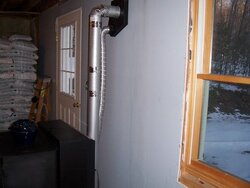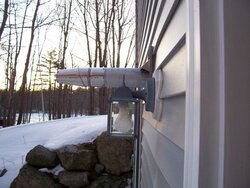My stove was installed by the dealer who used 3" ICC Excel pipe and a Harman wall thimble with OAK.
I have had to tape the seams due to a little leaking at startup. I have also had soot formed using softwood pellets on any feed rate above 3.5 (I know that the manual says to leave it at 4 and forget it). My ash is a darker color, almost black, and not grey.
I have read the following values are used to figure out EVL: 90 deg = 5, 1 ft horiz = 1, 1 ft vert = .5.
If the above is correct, ny EVL is 16.05 with the following: 2 90's, 65" rise and 41" horizontal.
I can do the changeover myself as I am now much more comfortable in the workings of a pellet stove. The question is this, is it worth the money to change? Am I losing more than the obvious listed above? I am leaning towards doing this over the summer.
I could always sell the 3" pipe to help the cost.
Any insight either way is appreciated.
Thanks
Geno
I have had to tape the seams due to a little leaking at startup. I have also had soot formed using softwood pellets on any feed rate above 3.5 (I know that the manual says to leave it at 4 and forget it). My ash is a darker color, almost black, and not grey.
I have read the following values are used to figure out EVL: 90 deg = 5, 1 ft horiz = 1, 1 ft vert = .5.
If the above is correct, ny EVL is 16.05 with the following: 2 90's, 65" rise and 41" horizontal.
I can do the changeover myself as I am now much more comfortable in the workings of a pellet stove. The question is this, is it worth the money to change? Am I losing more than the obvious listed above? I am leaning towards doing this over the summer.
I could always sell the 3" pipe to help the cost.
Any insight either way is appreciated.
Thanks
Geno



